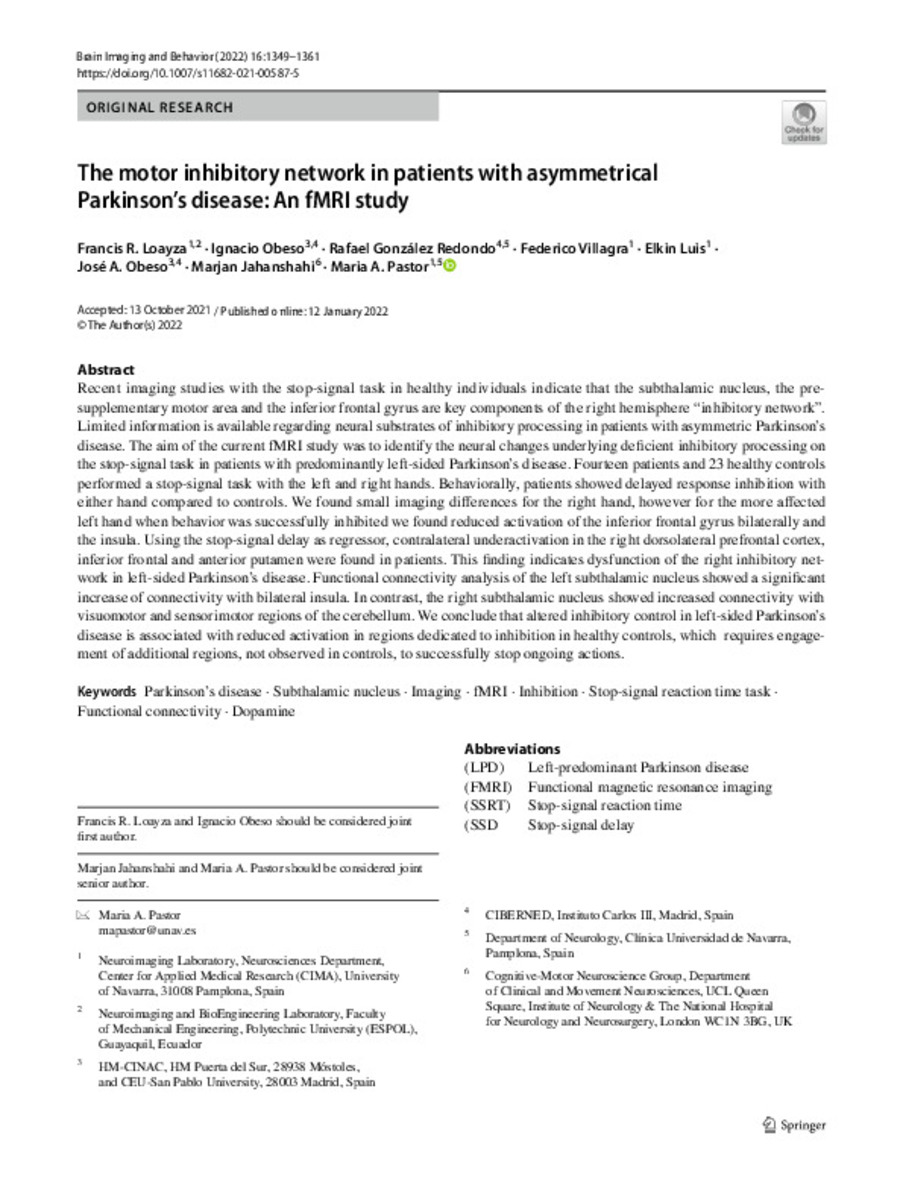Full metadata record
| DC Field | Value | Language |
|---|---|---|
| dc.creator | Loayza, F.R. (Francis R.) | - |
| dc.creator | Obeso, I. (Ignacio) | - |
| dc.creator | Gonzalez-Redondo, R. (R.) | - |
| dc.creator | Villagra, F. (Federico) | - |
| dc.creator | Luis, E. (Elkin) | - |
| dc.creator | Obeso, J.A. (José A.) | - |
| dc.creator | Jahanshahi, M. (Marjan) | - |
| dc.creator | Pastor, M.A. (María A.) | - |
| dc.date.accessioned | 2022-08-04T10:14:07Z | - |
| dc.date.available | 2022-08-04T10:14:07Z | - |
| dc.date.issued | 2022 | - |
| dc.identifier.citation | Loayza, F.R. (Francis R.); Obeso, I. (Ignacio); Gonzalez-Redondo, R. (R.); et al. "The motor inhibitory network in patients with asymmetrical Parkinson’s disease: a fMRI study". Brain Imaging and Behavior. (16), 2022, 1349 - 1361 | es |
| dc.identifier.issn | 1931-7565 | - |
| dc.identifier.uri | https://hdl.handle.net/10171/63871 | - |
| dc.description.abstract | Recent imaging studies with the stop-signal task in healthy individuals indicate that the subthalamic nucleus, the pre-supplementary motor area and the inferior frontal gyrus are key components of the right hemisphere “inhibitory network”. Limited information is available regarding neural substrates of inhibitory processing in patients with asymmetric Parkinson’s disease. The aim of the current fMRI study was to identify the neural changes underlying deficient inhibitory processing on the stop-signal task in patients with predominantly left-sided Parkinson’s disease. Fourteen patients and 23 healthy controls performed a stop-signal task with the left and right hands. Behaviorally, patients showed delayed response inhibition with either hand compared to controls. We found small imaging differences for the right hand, however for the more affected left hand when behavior was successfully inhibited we found reduced activation of the inferior frontal gyrus bilaterally and the insula. Using the stop-signal delay as regressor, contralateral underactivation in the right dorsolateral prefrontal cortex, inferior frontal and anterior putamen were found in patients. This finding indicates dysfunction of the right inhibitory network in left-sided Parkinson’s disease. Functional connectivity analysis of the left subthalamic nucleus showed a significant increase of connectivity with bilateral insula. In contrast, the right subthalamic nucleus showed increased connectivity with visuomotor and sensorimotor regions of the cerebellum. We conclude that altered inhibitory control in left-sided Parkinson’s disease is associated with reduced activation in regions dedicated to inhibition in healthy controls, which requires engagement of additional regions, not observed in controls, to successfully stop ongoing actions. | es_ES |
| dc.description.sponsorship | This research was funded by the FIMA University of Navarra (The Foundation for Applied Medical Research is the head entity of CIMA Universidad de Navarra) to the Neuroimaging Laboratory. | es_ES |
| dc.language.iso | eng | es_ES |
| dc.publisher | Springer | es_ES |
| dc.rights | info:eu-repo/semantics/openAccess | es_ES |
| dc.subject | Parkinson’s disease | es_ES |
| dc.subject | Subthalamic nucleus | es_ES |
| dc.subject | Imaging | es_ES |
| dc.subject | fMRI | es_ES |
| dc.subject | Inhibition | es_ES |
| dc.subject | Stop-signal reaction time task | es_ES |
| dc.subject | Functional connectivity | es_ES |
| dc.subject | Dopamine | es_ES |
| dc.title | The motor inhibitory network in patients with asymmetrical Parkinson’s disease: a fMRI study | es_ES |
| dc.type | info:eu-repo/semantics/article | es_ES |
| dc.description.note | This article is licensed under a Creative Commons Attribution 4.0 International License | es_ES |
| dc.identifier.doi | 10.1007/s11682-021-00587-5 | - |
| dadun.citation.endingPage | 1361 | es_ES |
| dadun.citation.number | 16 | es_ES |
| dadun.citation.publicationName | Brain Imaging and Behavior | es_ES |
| dadun.citation.startingPage | 1349 | es_ES |
Files in This Item:
Statistics and impact
Items in Dadun are protected by copyright, with all rights reserved, unless otherwise indicated.






